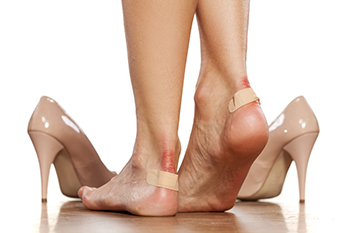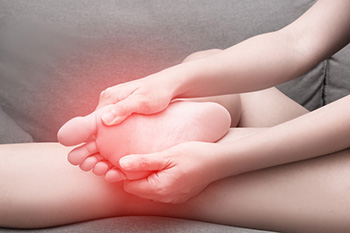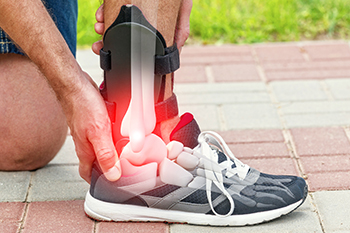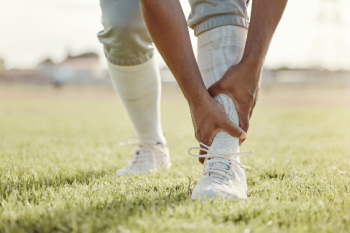Connect With Us
Blogs

Managing an Infected Blister

Blisters, often caused by friction from wearing ill-fitting shoes, are fluid-filled bubbles that protect injured skin. While they generally heal on their own, blisters can become infected if the protective skin breaks. An infected blister may feel warm, produce pus, and emit a foul odor. Other symptoms can include increased pain, swelling, and bleeding. Without proper care, an infected blister can lead to serious complications like cellulitis or sepsis, both of which require urgent medical attention. It is important to keep the blister clean and monitor it closely for signs of infection. If an infection is suspected, a podiatrist can provide the appropriate treatment, which might involve draining the blister and prescribing antibiotics or antifungal medications. Podiatrists are equipped to manage and treat infected blisters effectively, ensuring proper healing and preventing further health risks. If you have a foot blister that has become infected, it is suggested that you schedule an appointment with a podiatrist for an exam and treatment options.
Blisters may appear as a single bubble or in a cluster. They can cause a lot of pain and may be filled with pus, blood, or watery serum. If your feet are hurting, contact one of our podiatrists of Mt Rose Foot & Ankle Specialists. Our doctors can provide the care you need to keep you pain-free and on your feet.
Foot Blisters
Foot blisters are often the result of friction. This happens due to the constant rubbing from shoes, which can lead to pain.
What Are Foot Blisters?
A foot blister is a small fluid-filled pocket that forms on the upper-most layer of the skin. Blisters are filled with clear fluid and can lead to blood drainage or pus if the area becomes infected.
Symptoms
(Blister symptoms may vary depending on what is causing them)
- Bubble of skin filled with fluid
- Redness
- Moderate to severe pain
- Itching
Prevention & Treatment
In order to prevent blisters, you should be sure to wear comfortable shoes with socks that cushion your feet and absorb sweat. Breaking a blister open may increase your chances of developing an infection. However, if your blister breaks, you should wash the area with soap and water immediately and then apply a bandage to the affected area. If your blisters cause severe pain it is important that you call your podiatrist right away.
If you have any questions, please feel free to contact our office located in Reno, NV . We offer the newest diagnostic and treatment technologies for all your foot care needs.
Blisters
Blisters are pockets of fluid that occur under the top layer of your skin. These fluid pockets are usually filled with pus, blood, or serum. Blisters may itch or hurt and can appear as a single bubble or in clusters.
The most common types of blisters are friction blisters. This type of blister may be caused by wearing shoes that are too tight. Friction blisters can also occur on the hands. A change in temperature may also cause blisters on the feet. In the freezing air, frostbite on your toes can lead to blisters, as well as sunburn from hot weather.
The best way to treat a blister is to keep it clean and dry. Most blisters will get better on their own. Once the skin absorbs the fluid within the blister, it will flatten and eventually peel off. You should avoid popping your blister unless you podiatrist does it for you. Additional treatment options include applying an ice pack to the blister or using over-the-counter blister bandages to cover the affected area.
If your blister becomes discolored, inflamed, or worsens it is advised that you speak to your podiatrist. Blisters that are yellow, green, or purple may be infected and require immediate medical attention. Blisters that are abnormally colored may be a sign of a more serious underlying health condition such as herpes.
Causes and Treatment of Metatarsalgia
 Metatarsalgia, a painful inflammation in the ball of the foot, commonly stems from overuse injuries in sports that involve running and jumping. Wearing poorly fitting shoes, foot abnormalities like high arches or bunions, and conditions such as arthritis can also contribute to this condition. Pain in the ball of the foot typically develops gradually and may worsen with activities like standing, walking, or high-impact sports. Symptoms can include a sensation of walking on a pebble, sharp burning pain, and numbness or tingling in the toes. Treatment by a podiatrist focuses on addressing the underlying cause and relieving pain. Conservative measures include resting the foot and taking pain relievers. Changing to well-fitting shoes with good support and using orthotic pads can also help to alleviate discomfort. Weight loss, if applicable, can reduce pressure on the metatarsal area. In more persistent cases, custom orthotics may be recommended to improve gait and foot mechanics. Surgery is considered to be a last resort if conservative treatments fail. If you are experiencing pain in the ball of the foot, it is suggested that you schedule an appointment with a podiatrist for an exam, diagnosis, and treatment options.
Metatarsalgia, a painful inflammation in the ball of the foot, commonly stems from overuse injuries in sports that involve running and jumping. Wearing poorly fitting shoes, foot abnormalities like high arches or bunions, and conditions such as arthritis can also contribute to this condition. Pain in the ball of the foot typically develops gradually and may worsen with activities like standing, walking, or high-impact sports. Symptoms can include a sensation of walking on a pebble, sharp burning pain, and numbness or tingling in the toes. Treatment by a podiatrist focuses on addressing the underlying cause and relieving pain. Conservative measures include resting the foot and taking pain relievers. Changing to well-fitting shoes with good support and using orthotic pads can also help to alleviate discomfort. Weight loss, if applicable, can reduce pressure on the metatarsal area. In more persistent cases, custom orthotics may be recommended to improve gait and foot mechanics. Surgery is considered to be a last resort if conservative treatments fail. If you are experiencing pain in the ball of the foot, it is suggested that you schedule an appointment with a podiatrist for an exam, diagnosis, and treatment options.
Foot Pain
Foot pain can be extremely painful and debilitating. If you have a foot pain, consult with one of our podiatrists from Mt Rose Foot & Ankle Specialists. Our doctors will assess your condition and provide you with quality foot and ankle treatment.
Causes
Foot pain is a very broad condition that could be caused by one or more ailments. The most common include:
- Bunions
- Hammertoes
- Plantar Fasciitis
- Bone Spurs
- Corns
- Tarsal Tunnel Syndrome
- Ingrown Toenails
- Arthritis (such as Gout, Rheumatoid, and Osteoarthritis)
- Flat Feet
- Injury (from stress fractures, broken toe, foot, ankle, Achilles tendon ruptures, and sprains)
- And more
Diagnosis
To figure out the cause of foot pain, podiatrists utilize several different methods. This can range from simple visual inspections and sensation tests to X-rays and MRI scans. Prior medical history, family medical history, and any recent physical traumatic events will all be taken into consideration for a proper diagnosis.
Treatment
Treatment depends upon the cause of the foot pain. Whether it is resting, staying off the foot, or having surgery; podiatrists have a number of treatment options available for foot pain.
If you have any questions, please feel free to contact our office located in Reno, NV . We offer the newest diagnostic and treatment technologies for all your foot care needs.
Foot Pain
The feet, being the foundation of the body, carry all of the body’s weight and are therefore prone to experiencing pain and discomfort. If you are experiencing foot pain, it is important to determine where in the foot you are experiencing this pain to help discover the cause of it. While pain can be experienced virtually anywhere in the foot, the most common sites of foot pain are in the heel and ankle.
Heel pain can be due to a multitude of conditions including plantar fasciitis, Achilles tendinitis, and heel spurs. Pain experienced in the ankle can be a sign of an ankle sprain, arthritis, gout, ankle instability, ankle fracture, or nerve compression. In more serious cases, pain in the foot can be a sign of improper alignment or an infection.
Foot pain can be accompanied by symptoms including redness, swelling, stiffness and warmth in the affected area. Whether the pain can be described as sharp or dull depends on the foot condition behind it. It is important to visit your local podiatrist if your foot pain and its accompanying symptoms persist and do not improve over time.
Depending on the location and condition of your foot pain, your podiatrist may prescribe certain treatments. These treatments can include but are not limited to prescription or over-the-counter drugs and medications, certain therapies, cortisone injections, or surgery.
If you are experiencing persistent foot pain, it is important to consult with your foot and ankle doctor to determine the cause and location. He or she will then prescribe the best treatment for you. While milder cases of foot pain may respond well to rest and at-home treatments, more serious cases may take some time to fully recover.
The Importance of Ankle-Foot Orthosis for Various Ankle Issues

Ankle-foot orthosis, or AFO, is the most commonly prescribed orthosis for individuals with foot drop and various ankle and foot problems. This medical device supports the foot and ankle, improving stability and mobility. Made from lightweight, durable materials such as plastic, carbon fiber, or a combination, AFOs provide a custom fit tailored to the patient's specific needs. They function by holding the foot in a fixed position, preventing it from dragging while walking, thereby reducing the risk of tripping. AFOs are essential for individuals with conditions like a stroke, multiple sclerosis, cerebral palsy, and other neurological disorders that cause muscle weakness. By offering essential support and enhancing gait, AFOs significantly improve the quality of life for those with foot drop and related ankle and foot issues. If you have a specific ankle condition, it is suggested that you consult a podiatrist who can determine if an ankle-foot orthosis is the right choice for you.
If you are having discomfort in your feet and would like to try orthotics, contact one of our podiatrists from Mt Rose Foot & Ankle Specialists. Our doctors can provide the care you need to keep you pain-free and on your feet.
What Are Orthotics?
Orthotics are inserts you can place into your shoes to help with a variety of foot problems such as flat feet or foot pain. Orthotics provide relief and comfort for minor foot and heel pain but can’t correct serious biomechanical problems in your feet.
Over-the-Counter Inserts
Orthotics come in a wide variety of over-the-counter inserts that are used to treat foot pain, heel pain, and minor problems. For example, arch supports can be inserted into your shoes to help correct overarched or flat feet, while gel insoles are often used because they provide comfort and relief from foot and heel pain by alleviating pressure.
Prescription Orthotics
If over-the-counter inserts don’t work for you or if you have a more severe foot concern, it is possible to have your podiatrist prescribe custom orthotics. These high-quality inserts are designed to treat problems such as abnormal motion, plantar fasciitis, and severe forms of heel pain. They can even be used to help patients suffering from diabetes by treating foot ulcers and painful calluses and are usually molded to your feet individually, which allows them to provide full support and comfort.
If you are experiencing minor to severe foot or heel pain, it’s recommended to speak with your podiatrist about the possibilities of using orthotics. A podiatrist can determine which type of orthotic is right for you and allow you to take the first steps towards being pain-free.
If you have any questions please contact our office located in Reno, NV . We offer the newest diagnostic and treatment technologies for all your foot and ankle needs.
Ankle Foot Orthotics for Athletes
Ankle foot orthotics are shoe inserts that offer support to control the placement and movement of the ankle, correct deformities, and compensate for weakness. These inserts are used to stabilize the foot and ankle and provide toe clearance during the swing phase of gate.
Athletes often suffer foot problems because their feet are not being supported within the shoe. Ankle and foot orthotics are custom made inserts that alleviate stress on the foot. However custom orthotics should be prescribed by a podiatrist who specializes in customized footwear and orthotics design. These inserts are used by athletes for different reasons. Runners use orthotics to absorb shock at heel contact and to set up the forefoot for push-off. Basketball players wear them to control their forefeet while jumping and running.
The two main types of orthotics are over-the-counter orthotics and custom-made orthotics. To be eligible for custom orthotics, an examination of the foot and ankle will need to be completed. Afterward, both the foot and ankle will need to be casted and fitted for the proper orthotic. When the fitting process is complete, adjustments can be made to make sure everything fits perfectly.
Over the counter orthotics tend to be more popular than custom fit ones. Athletes who have less severe aches and pains in the foot, ankle or lower back area can use the over-the-counter version of orthotics. Unfortunately, over-the-counter orthotics tend to not work in treating severe injuries or ailments. Whenever you suspect you may need an ankle foot orthotic, you should consult with your podiatrist to determine which type of orthotic is right for you.
Wounds That Don't Heal Need to Be Checked
Pronation Can Affect Your Running

Pronation is the natural side-to-side movement of the foot during walking or running. It is essential for shock absorption and navigating uneven surfaces. However, problems arise when this movement is excessive. Overpronation, where the foot rolls too far inward, can cause prolonged ground contact and increased stress on the leg's alignment. This may lead to injuries like plantar fasciitis, shin splints, and knee pain. Conversely, underpronation, or insufficient inward roll, causes the foot to remain rigid, failing to absorb shock effectively. This places undue stress on the outer edge of the foot, increasing the likelihood of stress fractures. Identifying pronation issues can often be done through a professional gait analysis conducted by a podiatrist. In some cases, a podiatrist might recommend custom orthotics to provide additional support and correct alignment issues. Selecting appropriate footwear and strengthening foot and ankle muscles can help manage pronation-related problems. If you experience foot pain linked to pronation, it is suggested that you make an appointment with a podiatrist for an exam and treatment.
If you have any concerns about your feet, contact one of our podiatrists from Mt Rose Foot & Ankle Specialists. Our doctors can provide the care you need to keep you pain-free and on your feet.
Biomechanics in Podiatry
Podiatric biomechanics is a particular sector of specialty podiatry with licensed practitioners who are trained to diagnose and treat conditions affecting the foot, ankle and lower leg. Biomechanics deals with the forces that act against the body, causing an interference with the biological structures. It focuses on the movement of the ankle, the foot and the forces that interact with them.
A History of Biomechanics
- Biomechanics dates back to the BC era in Egypt where evidence of professional foot care has been recorded.
- In 1974, biomechanics gained a higher profile from the studies of Merton Root, who claimed that by changing or controlling the forces between the ankle and the foot, corrections or conditions could be implemented to gain strength and coordination in the area.
Modern technological improvements are based on past theories and therapeutic processes that provide a better understanding of podiatric concepts for biomechanics. Computers can provide accurate information about the forces and patterns of the feet and lower legs.
Understanding biomechanics of the feet can help improve and eliminate pain, stopping further stress to the foot.
If you have any questions please feel free to contact our office located in Reno, NV . We offer the newest diagnostic and treatment technologies for all your foot and ankle needs.
The Importance of Biomechanics in Podiatry
Biomechanics and its related study deal with the forces that act against the body and affect things like our movement. In podiatry, biomechanics are studied to determine the movement of the ankle, toes, and the foot, as well as the forces that impact them. Podiatrists who train in this specialty are able to effectively diagnose and treat conditions that affect people’s everyday movement.
Regardless of your lifestyle, age, or any other factors, many people experience foot problems throughout their lives. Twists and turns, improper balance, and added weight are just a few of the things that can add stress to the feet. These issues can also limit our bodies’ mobility that we often take for granted. Pain in the feet and ankles can also trickle up towards the lower legs, knees, hip, and even back area. This affects the way you move around on a daily basis.
Biomechanics and its related study deal with forces that act against the body and affect things like our movement. In podiatry, biomechanics are studied to determine the movement of the ankle, toes, and the foot, as well as the forces that impact them. Podiatrists who train in this specialty are able to effectively diagnose and treat conditions that affect people’s everyday movement.
Regardless of your lifestyle, age, or any other factors, many people experience foot problems throughout their lives. Twists and turns, improper balance, and added weight are just a few of the things that can add stress to the feet. These issues can also limit our bodies’ mobility that we often take for granted. Pain in the feet and ankles can also trickle up towards the lower legs, knees, hip, and even back area. This affects the way you move around on a daily basis.
The history of studying biomechanics dates back to ancient Egypt at around 3000 B.C., where evidence of professional foot care has been recorded. Throughout the centuries, advances in technology, science, and an understanding of the human body led to more accurate diagnosis of conditions such as corns for example. In 1974, biomechanics garnered a large audience when Merton Root founded Root Lab to make custom orthotics. He proposed that corrections of certain conditions could be implemented to gain strength and coordination in the area. Due to his research, we still use his basic principle of foot orthotics to this day.
As technology has improved, so have the therapeutic processes that allow us to correct deficiencies in our natural biomechanics. Computers can now provide accurate readings of the forces, movements, and patterns of the foot and lower leg. Critical treatment options can be provided to patients now who suffer from problems that cause their biomechanics to not function naturally. The best results are now possible thanks to 3D modeling and computing technologies that can take readings and also map out what treatment will do to the affected areas.
These advanced corrective methods were able to come to light thanks to an increase in both the technologies surrounding biomechanics and also the knowledge of how they work naturally. For example, shoe orthotics are able to treat walking inabilities by realigning the posture deviations in patients caused by hip or back problems. Understanding foot biomechanics can help improve movement and eliminate pain, stopping further stress to the foot. Speak with your podiatrist if you have any of these problems.
Sports Overuse Injuries in Young People
 Sports-related injuries are common in children and adolescents, particularly affecting the feet due to the high impact and repetitive stress involved in athletic activities. Growth plates, the areas of developing tissues at the ends of long bones, are vulnerable during this stage, making young athletes more susceptible to injuries such as fractures, sprains, and strains. Many of these injuries are related to overuse, where repetitive stress leads to wear and tear on the feet. Common foot injuries in this age group include Sever's disease, an inflammation of the growth plate in the heel, and stress fractures, small cracks in the bone caused by repetitive force. Other issues like ankle sprains and plantar fasciitis, which is inflammation of the tissue along the bottom of the foot, are also prevalent. Prevention strategies include proper warm-up exercises, wearing appropriate and well-fitting footwear, and ensuring adequate rest to avoid overuse injuries. Parents and coaches should encourage young athletes to listen to their bodies and seek medical attention when pain persists. If you have a young athlete in the family, it is suggested that you schedule regular visits to a podiatrist to maintain foot health and address any injuries promptly.
Sports-related injuries are common in children and adolescents, particularly affecting the feet due to the high impact and repetitive stress involved in athletic activities. Growth plates, the areas of developing tissues at the ends of long bones, are vulnerable during this stage, making young athletes more susceptible to injuries such as fractures, sprains, and strains. Many of these injuries are related to overuse, where repetitive stress leads to wear and tear on the feet. Common foot injuries in this age group include Sever's disease, an inflammation of the growth plate in the heel, and stress fractures, small cracks in the bone caused by repetitive force. Other issues like ankle sprains and plantar fasciitis, which is inflammation of the tissue along the bottom of the foot, are also prevalent. Prevention strategies include proper warm-up exercises, wearing appropriate and well-fitting footwear, and ensuring adequate rest to avoid overuse injuries. Parents and coaches should encourage young athletes to listen to their bodies and seek medical attention when pain persists. If you have a young athlete in the family, it is suggested that you schedule regular visits to a podiatrist to maintain foot health and address any injuries promptly.
The health of a child’s feet is vital to their overall well-being. If you have any questions regarding foot health, contact one of our podiatrists of Mt Rose Foot & Ankle Specialists. Our doctors can provide the care you need to keep you pain-free and on your feet.
Tips for Keeping Children's Feet Healthy
- Make sure their shoes fit properly
- Look for any signs of in-toeing or out-toeing
- Check to see if they have Clubfoot (condition that affects your child’s foot and ankle, twisting the heel and toes inward) which is one of the most common nonmajor birth defects.
- Lightly cover your baby’s feet (Tight covers may keep your baby from moving their feet freely, and could prevent normal development)
- Allow your toddler to go shoeless (Shoes can be restricting for a young child’s foot)
- Cut toenails straight across to avoid ingrown toenails
- Keep your child’s foot clean and dry
- Cover cuts and scrapes. Wash any scratches with soap and water and cover them with a bandage until they’ve healed.
If you have any questions, please feel free to contact our office located in Reno, NV . We offer the newest diagnostic and treatment technologies for all your foot care needs.







